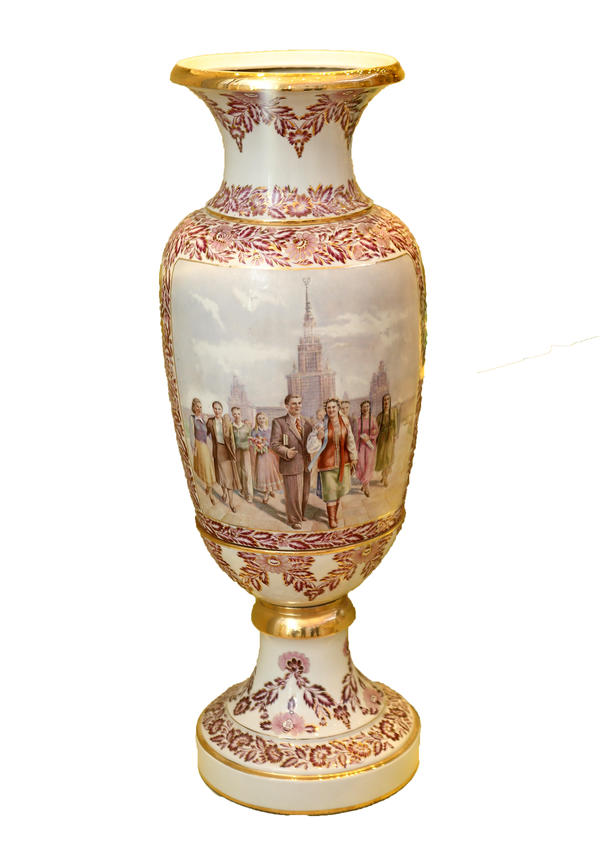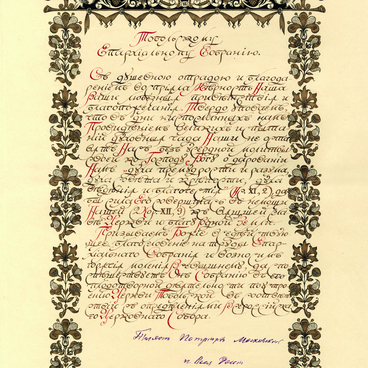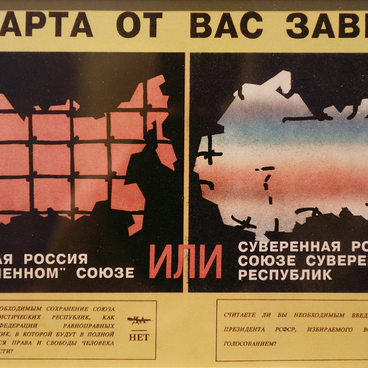The exposition displays a decorative vase made for the 300th anniversary of the reunification of Ukraine and Russia. This date was celebrated in 1953 at the initiative of Nikita Khrushchev.
The decision to attach Ukraine to the territory of the Muscovite State was taken in 1653 at the Zemsky Sobor (‘Assembly of the Land’) in Moscow. The Sobor included representatives of three classes: the clergy, the nobility, and townspeople with the merchants. In 1653, the full bench of the Sobor assembled for the last time.
In the middle 17th century, Ukraine was part of the Polish-Lithuanian Commonwealth. The Polish government constantly increased feudal services, and also, since Catholicism was the official religion of the state, Orthodox Ukrainians were oppressed.
These and other factors led to the uprising of 1648 led by Bohdan Khmelnitsky. Ukrainian rebels, mostly consisting of peasants, Cossacks and townees, won several victories over the forces of the Commonwealth, and Khmelnitsky asked Tsar Alexei Mikhailovich to accept Ukraine as part of Russia.
Russia was not ready for a war with Poland by then, so the sovereign rejected the request. However, he began to provide support to Ukraine, that is, he ordered to arrange the supply of weapons and provisions for the rebels. And in 1651, the Russian government announced its readiness to provide Ukraine with Russian citizenship. Initially, such a statement was planned only to put pressure on the Commonwealth, but two years later, Alexei Mikhailovich announced this intention officially.
In 1654, the Russo-Polish War began. It lasted almost 13 years, and as a result, Poland was forced to recognize the accession of Left-Bank Ukraine to the Muscovite State.
The historic decision to reunite Ukraine and Russia was made in winter, but the celebration of the 300th anniversary in the Soviet Union was postponed to spring. The demonstration on Khreshchatyk, the main street of Kiev, was held on May 24. In Moscow, several objects at once were renamed in honor of the festive date. Taras Shevchenko Embankment and a monument to the writer, Ukrainsky Boulevard, the Ukraina Hotel, and Kievskaya Metro Station appeared in the city. The History Museum arranged a thematic exhibition. One of its exhibits was this vase made at the Korosten porcelain factory in Zhitomir Region.
The decision to attach Ukraine to the territory of the Muscovite State was taken in 1653 at the Zemsky Sobor (‘Assembly of the Land’) in Moscow. The Sobor included representatives of three classes: the clergy, the nobility, and townspeople with the merchants. In 1653, the full bench of the Sobor assembled for the last time.
In the middle 17th century, Ukraine was part of the Polish-Lithuanian Commonwealth. The Polish government constantly increased feudal services, and also, since Catholicism was the official religion of the state, Orthodox Ukrainians were oppressed.
These and other factors led to the uprising of 1648 led by Bohdan Khmelnitsky. Ukrainian rebels, mostly consisting of peasants, Cossacks and townees, won several victories over the forces of the Commonwealth, and Khmelnitsky asked Tsar Alexei Mikhailovich to accept Ukraine as part of Russia.
Russia was not ready for a war with Poland by then, so the sovereign rejected the request. However, he began to provide support to Ukraine, that is, he ordered to arrange the supply of weapons and provisions for the rebels. And in 1651, the Russian government announced its readiness to provide Ukraine with Russian citizenship. Initially, such a statement was planned only to put pressure on the Commonwealth, but two years later, Alexei Mikhailovich announced this intention officially.
In 1654, the Russo-Polish War began. It lasted almost 13 years, and as a result, Poland was forced to recognize the accession of Left-Bank Ukraine to the Muscovite State.
The historic decision to reunite Ukraine and Russia was made in winter, but the celebration of the 300th anniversary in the Soviet Union was postponed to spring. The demonstration on Khreshchatyk, the main street of Kiev, was held on May 24. In Moscow, several objects at once were renamed in honor of the festive date. Taras Shevchenko Embankment and a monument to the writer, Ukrainsky Boulevard, the Ukraina Hotel, and Kievskaya Metro Station appeared in the city. The History Museum arranged a thematic exhibition. One of its exhibits was this vase made at the Korosten porcelain factory in Zhitomir Region.



